Cyclostationary Impulsive Noise Mitigation in the Presence of Cyclic Frequency Offset for Narrowband Powerline Communication Systems
Abstract
1. Introduction
2. System Models
2.1. Powerline Channel Model
2.2. CSIN Model
3. Proposed FRESH-Filter Receivers
3.1. Adaptive FRESH Filter
3.2. Cyclic Frequency Offset Estimation and Compensation
4. Simulation Results
4.1. Evaluation of CSIN Estimation Module
4.2. Evaluation of the BER Performance
5. Conclusions and Discussion
- (1)
- Cyclic frequency offset could degrade the performance of the FRESH-filter receiver to below that of the case without CSIN mitigation. Without the compensation for cyclic frequency offset, it could results in a loss of required about 0.9 dB and 3.3 dB for the case of no CSIN mitigation and the case of no cyclic frequency offset, respectively.
- (2)
- Our approach to estimating cyclic frequency offset by observing the phase variation of the tap weights of the FRESH filter made it possible to suppress the cyclic frequency relative error by at least 15.45 dB (from to ).
- (3)
- Following compensation for cyclic frequency offset, attaining a BER of imposed an loss of only 0.7 dB compared with the ideal case ( Hz).
- (4)
- When the value of was fixed at 24 dB, the resulting BERs were as follows: proposed method () and the case without cyclic frequency offset compensation ().
Author Contributions
Funding
Conflicts of Interest
Abbreviations
| AWGN | additive white Gaussian noise |
| BER | bit error rate |
| CFRE | cyclic frequency relative error |
| CP | cyclic prefix |
| CSD | cyclic spectrum density |
| CSIN | cyclostationary impulsive noise |
| DBPSK | differential binary phase shift keying |
| ESR | error-to-signal power ratio |
| FEC | forward error correction |
| FEQ | frequency-domain equalization |
| FFT | fast Fourier transform |
| FIR | finite impulse response |
| FRESH | frequency-shift |
| FS | Fourier series |
| GINR | Gaussian-to-impulsive-noise ratio |
| IFFT | inverse fast Fourier transform |
| LPTV | linear periodically time-variant |
| LTI | linear time-invariant |
| MSE | mean square error |
| MUX | multiplexer |
| NB-PLC | narrowband powerline communication |
| OFDM | orthogonal frequency division multiplexing |
| PSCGM | piecewise spectral cyclostationary Gaussian model |
| RLS | recursive least-squares |
| SINR | signal-to-interference-plus-noise ratio |
| SNR | signal-to-noise ratio |
| TA-LMS | time-averaged least mean squared |
References
- Sharma, K.; Saini, L.M. Power-line communications for smart grid: Progress, challenges, opportunities and status. Renew. Sustain. Energy Rev. 2017, 67, 704–751. [Google Scholar] [CrossRef]
- ElSamadouny, A.; Shafie, A.E.; Abdallah, M.; Al-Dhahir, N. Secure Sum-Rate-Optimal MIMO Multicasting Over Medium-Voltage NB-PLC Networks. IEEE Trans. Smart Grid 2018, 9, 2954–2963. [Google Scholar] [CrossRef]
- Aalamifar, F.; Lampe, L. Optimized Data Acquisition Point Placement for an Advanced Metering Infrastructure Based on Power Line Communication Technology. IEEE Access 2018, 6, 45347–45358. [Google Scholar] [CrossRef]
- Sayed, M.; Tsiftsis, T.A.; Al-Dhahir, N. On the Diversity of Hybrid Narrowband-PLC/Wireless Communications for Smart Grids. IEEE Trans. Wirel. Commun. 2017, 16, 4344–4360. [Google Scholar] [CrossRef]
- Guerrieri, L.; Masera, G.; Stievano, I.S.; Bisaglia, P.; Valverde, W.R.G.; Concolato, M. Automotive Power-Line Communication Channels: Mathematical Characterization and Hardware Emulator. IEEE Trans. Ind. Electron. 2016, 63, 3081–3090. [Google Scholar] [CrossRef]
- Han, B.; Stoica, V.; Kaiser, C.; Otterbach, N.; Dostert, K. Noise characterization and emulation for low-voltage power line channels across narrowband and broadband. Digit. Signal Process. 2017, 69, 259–274. [Google Scholar] [CrossRef]
- Bai, L.; Tucci, M.; Barmada, S.; Raugi, M.; Zheng, T. Impulsive Noise Characterization in Narrowband Power Line Communication. Energies 2018, 11, 863. [Google Scholar] [CrossRef]
- Himeur, Y.; Boukabou, A. An efficient impulsive noise cancellation scheme for power-line communication systems using ANFIS and chaotic interleaver. Digit. Signal Process. 2017, 66, 42–55. [Google Scholar] [CrossRef]
- Shebl, S.; Soliman, N.F.; El-Fishawy, N.A.; Abou-El-Azm, A.E.; Alshebeili, S.A.; El-Samie, F.E.A. Performance enhancement of power line communication systems with efficient low density parity-check codes, noise removal, equalization, and chaotic interleaving. Digit. Signal Process. 2013, 23, 1933–1944. [Google Scholar] [CrossRef]
- Masood, B.; Baig, S. Standardization and deployment scenario of next generation NB-PLC technologies. Renew. Sustain. Energy Rev. 2016, 65, 1033–1047. [Google Scholar] [CrossRef]
- Narrowband Orthogonal Frequency Division Multiplexing Powerline Communication Transceivers for PRIME Networks, ITU-TRec G.9904. 2012. Available online: http://www.itu.int/rec/T-REC-G.9904/en (accessed on 5 February 2020).
- Narrowband Orthogonal Frequency Division Multiplexing Powerline Communication Transceivers for G3-PLC Networks, ITU-TRec G.9903. 2017. Available online: http://www.itu.int/rec/T-REC-G.9903/en (accessed on 5 February 2020).
- IEEE. Standard for Low-Frequency (Less than 500 kHz) Narrowband Power Line Communications for Smart Grid Applications; IEEE Std 1901.2-2013; IEEE: Piscataway, NJ, USA, 2013; pp. 1–269. [Google Scholar]
- Chien, Y.R.; Xu, S.S.D.; Lu, S.H. Cyclostationary impulsive noise mitigation algorithm for narrowband powerline communications. J. Frankl. Inst. 2020, 357, 687–703. [Google Scholar] [CrossRef]
- Chen, Y.X.; Lai, R.S.; Lu, S.H.; Chien, Y.R. Performance Assessment Under Different Impulsive Noise Models for Narrowband Powerline Communications. Front. Comput. 2017. Lect. Notes Electr. Eng. 2018, 464, 432–437. [Google Scholar] [CrossRef]
- Widrow, B.; Glover, J.R.; McCool, J.M.; Kaunitz, J.; Williams, C.S.; Hearn, R.H.; Zeidler, J.R.; Eugene Dong, J.; Goodlin, R.C. Adaptive noise cancelling: Principles and applications. Proc. IEEE 1975, 63, 1692–1716. [Google Scholar] [CrossRef]
- Barazideh, R.; Nikitin, A.V.; Natarajan, B. Practical Implementation of Adaptive Analog Nonlinear Filtering for Impulsive Noise Mitigation. In Proceedings of the 2018 IEEE International Conference on Communications (ICC), Kansas City, MO, USA, 20–24 May 2018; pp. 1–7. [Google Scholar] [CrossRef][Green Version]
- Barazideh, R.; Natarajan, B.; Nikitin, A.V.; Davidchack, R.L. Performance of analog nonlinear filtering for impulsive noise mitigation in OFDM-based PLC systems. In Proceedings of the 2017 IEEE 9th Latin-American Conference on Communications (LATINCOM), Guatemala City, Guatemala, 8–10 November 2017; pp. 1–6. [Google Scholar] [CrossRef]
- Cañete, F.J.; Díez, L.; Cortés, J.A.; Entrambasaguas, J.T. Cyclic Signals and Systems in Power Line Communications. IEEE Access 2019, 7, 96799–96817. [Google Scholar] [CrossRef]
- Tian, J.; Guo, H.; Hu, H.; Chen, H.H. Frequency-Shift Filtering for OFDM Systems and Its Performance Analysis. IEEE Syst. J. 2011, 5, 314–320. [Google Scholar] [CrossRef]
- Shlezinger, N.; Dabora, R. Frequency-Shift Filtering for OFDM Signal Recovery in Narrowband Power Line Communications. IEEE Trans. Commun. 2014, 62, 1283–1295. [Google Scholar] [CrossRef]
- Shlezinger, N.; Todros, K.; Dabora, R. Adaptive Filtering Based on Time-Averaged MSE for Cyclostationary Signals. IEEE Trans. Commun. 2017, 65, 1746–1761. [Google Scholar] [CrossRef]
- Elgenedy, M.; Sayed, M.; Al-Dhahir, N.; Chabaan, R.C. Cyclostationary Noise Mitigation for SIMO Powerline Communications. IEEE Access 2018, 6, 5460–5484. [Google Scholar] [CrossRef]
- Butusov, D.; Karimov, T.; Voznesenskiy, A.; Kaplun, D.; Andreev, V.; Ostrovskii, V. Filtering Techniques for Chaotic Signal Processing. Electronics 2018, 7, 450. [Google Scholar] [CrossRef]
- Carroll, T.L. Using the cyclostationary properties of chaotic signals for communications. IEEE Trans. Circuits Syst. I Fundam. Theory Appl. 2002, 49, 357–362. [Google Scholar] [CrossRef]
- Xi, F.; Liu, Z. Modelling and Prediction of Cyclostationary Chaotic Time Series Using Vector Autoregressive Models. In Proceedings of the 2006 IEEE International Symposium on Signal Processing and Information Technology, Vancouver, BC, Canada, 27–30 August 2006; pp. 468–473. [Google Scholar]
- The Electricity Act. 2019. Available online: https://law.moj.gov.tw/ENG/LawClass/LawAll.aspx?pcode=J0030011 (accessed on 5 February 2020).
- Ojeda, O.A.Y.; Grajal, J. Adaptive-FRESH Filters for Compensation of Cycle-Frequency Errors. IEEE Trans. Signal Process. 2010, 58, 1–10. [Google Scholar] [CrossRef]
- Zimmermann, M.; Dostert, K. A Multipath Model for the Power Line Channel. IEEE Trans. Commun. 2002, 50, 553–559. [Google Scholar] [CrossRef]
- Masood, B.; Nazar, W.; Masood, R. Channel Modeling of Low Voltage NB-PLC Network using Statistical and Deterministic Channel Modeling Approaches. In Proceedings of the 2018 7th International Conference on Renewable Energy Research and Applications (ICRERA), Paris, France, 14–17 October 2018; pp. 693–696. [Google Scholar]
- Katayama, M.; Yamazato, T.; Okada, H. A mathematical model of noise in narrowband power line communication systems. IEEE J. Sel. Areas Commun. 2006, 24, 1267–1276. [Google Scholar] [CrossRef]
- Nieman, K.; Lin, J.; Nassar, M.; Waheed, K.; Evans, B. Cyclic Spectral Analysis of Power Line Noise in the 3–200 kHz Band. In Proceedings of the 2013 IEEE International Symposium on Power Line Communications and Its Applications (ISPLC), Johannesburg, South Africa, 24–27 March 2013; pp. 315–320. [Google Scholar]
- Nassar, M.; Lin, J.; Mortazavi, Y.; Dabak, A.; Kim, I.H.; Evans, B. Local Utility Power Line Communications in the 3–500 kHz Band: Channel Impairments, Noise, and Standards. IEEE Signal Process. Mag. 2012, 29, 116–127. [Google Scholar] [CrossRef]
- Elgenedy, M.; Sayed, M.; Shafie, A.E.; Kim, I.H.; Al-Dhahir, N. Cyclostationary Noise Modeling Based on Frequency-Shift Filtering in NB-PLC. In Proceedings of the 2016 IEEE Global Communications Conference (GLOBECOM), Washington, DC, USA, 4–8 December 2016; pp. 1–6. [Google Scholar]
- Gardner, W.A. Cyclostationarity in Communications and Signal Processing; IEEE Press: Piscataway, NJ, USA, 1994. [Google Scholar]
- Kumar, M.; Dabora, R. A Novel Sampling Frequency Offset Estimation Algorithm for OFDM Systems Based on Cyclostationary Properties. IEEE Access 2019, 7, 100692–100705. [Google Scholar] [CrossRef]
- Morelli, M.; Moretti, M. Fine carrier and sampling frequency synchronization in OFDM systems. IEEE Trans. Wirel. Commun. 2010, 9, 1514–1524. [Google Scholar] [CrossRef]
- Datta, J.; Lin, H.P. Fast Convolution Filter-Bank Based Non-Orthogonal Multiplexed Cognitive Radio (NOMCR) Receiver Design Using Cyclostationarity Based FRESH Filtering. Sensors 2018, 18, 1930. [Google Scholar] [CrossRef]
- Sayed, A.H. RLS Algorithm. In Adaptive Filters; Chapter 14; John Wiley & Sons, Ltd.: Hoboken, NJ, USA, 2008; pp. 198–201. [Google Scholar] [CrossRef]
- Woo, T.-K. HRLS: A more efficient RLS algorithm for adaptive FIR filtering. IEEE Commun. Lett. 2001, 5, 81–84. [Google Scholar]
- Zakharov, Y.V.; White, G.P.; Liu, J. Low-Complexity RLS Algorithms Using Dichotomous Coordinate Descent Iterations. IEEE Trans. Signal Process. 2008, 56, 3150–3161. [Google Scholar] [CrossRef]
- Raghunath, K.J.; Parhi, K.K. Finite-precision error analysis of QRD-RLS and STAR-RLS adaptive filters. IEEE Trans. Signal Process. 1997, 45, 1193–1209. [Google Scholar] [CrossRef]
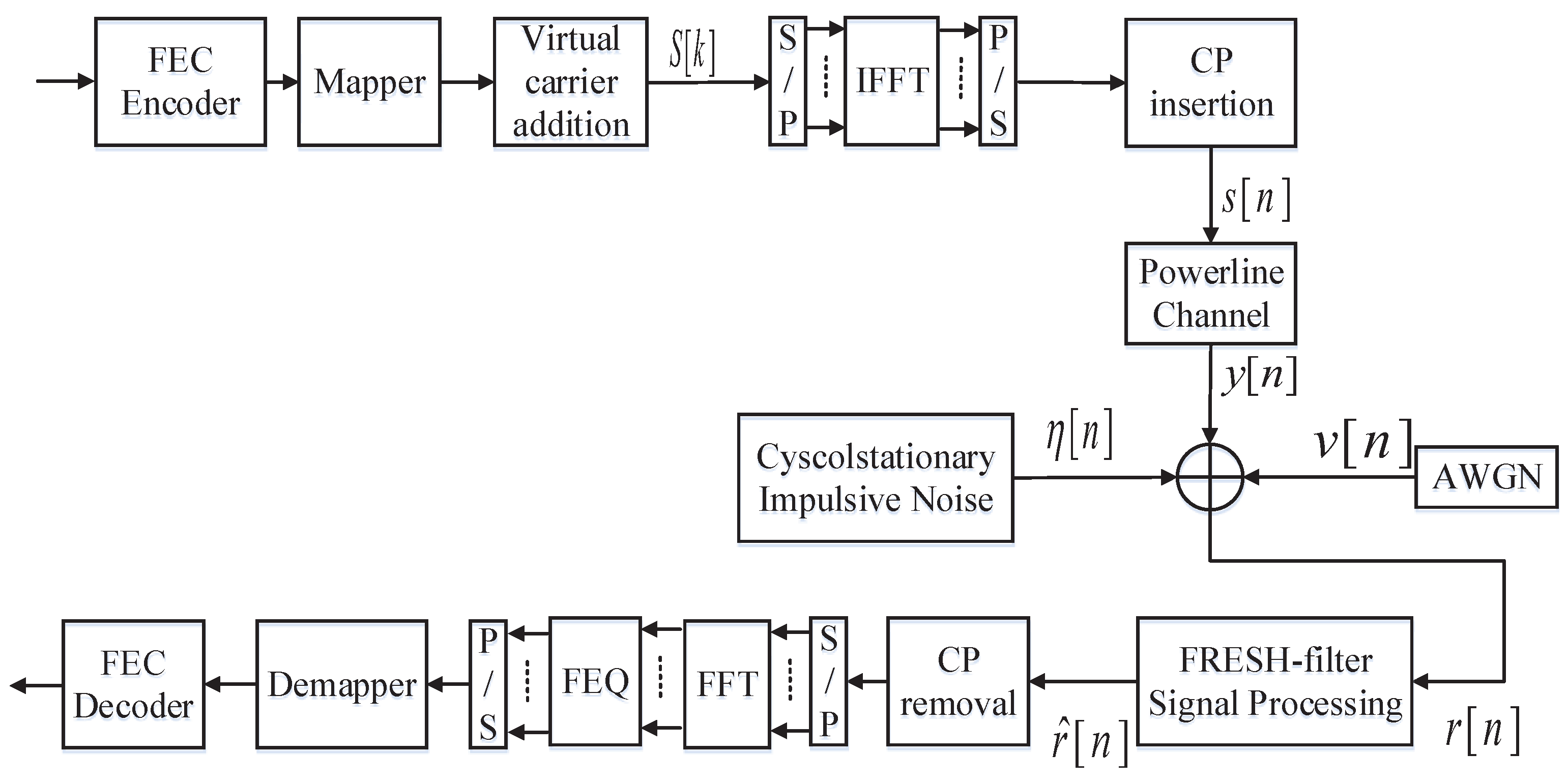
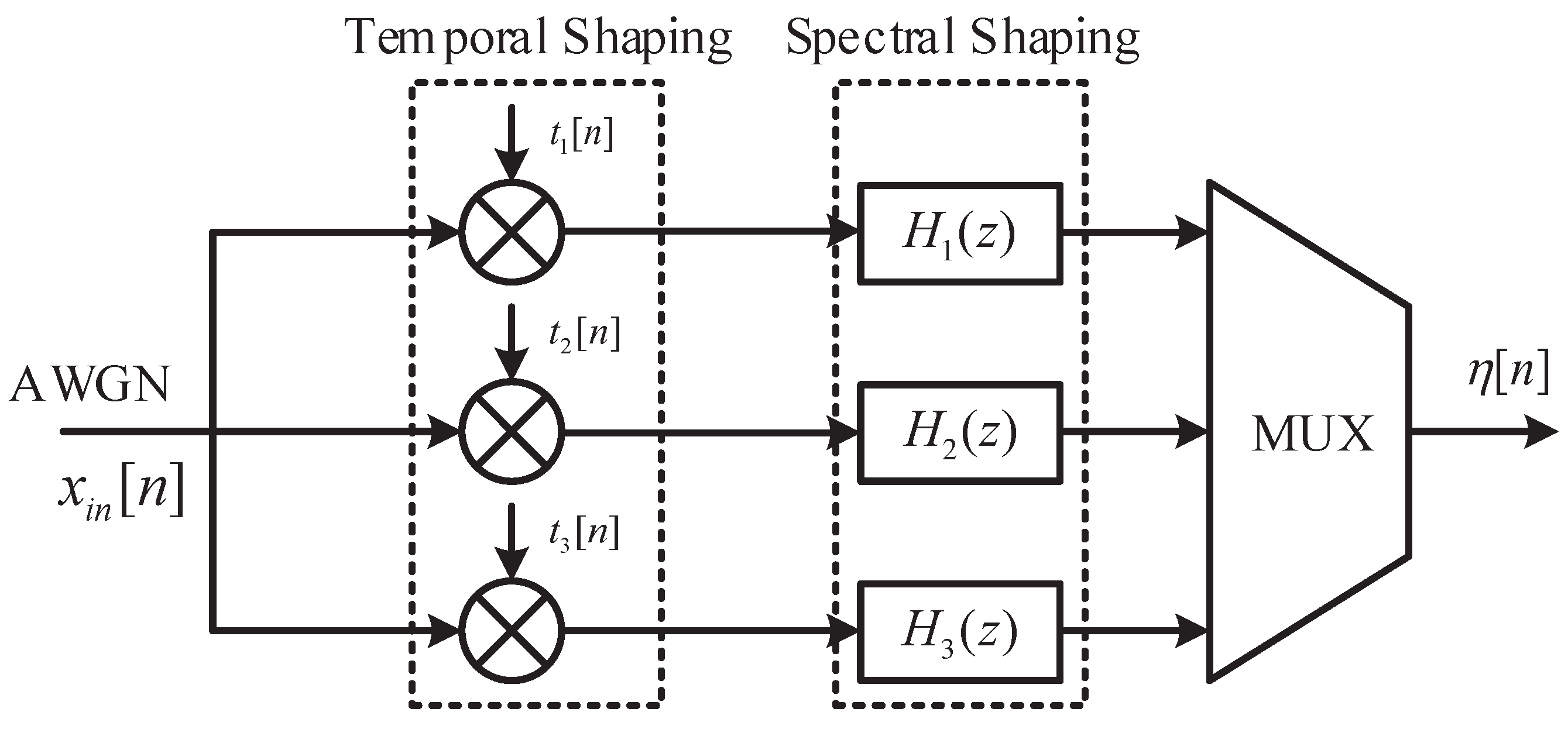

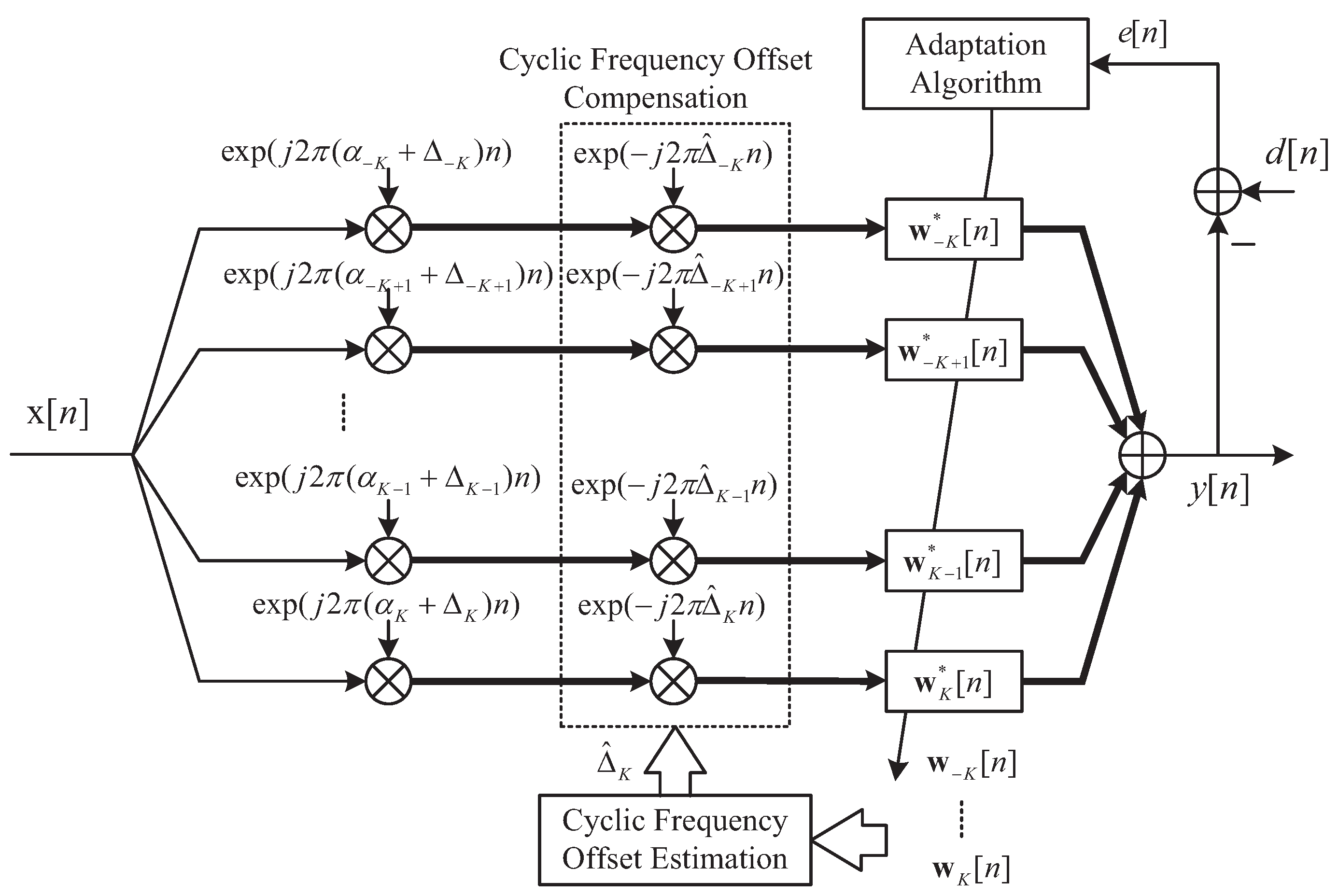
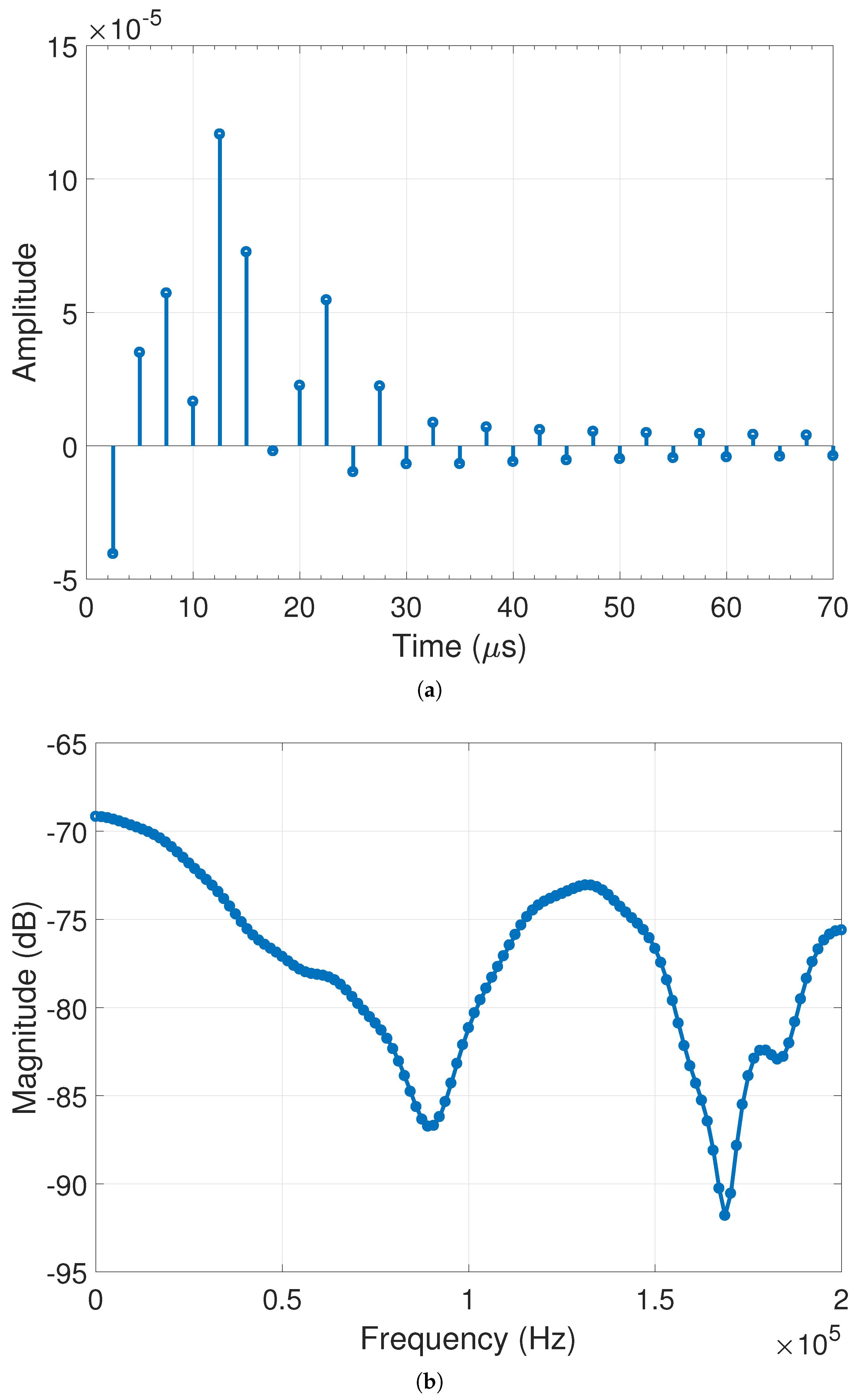
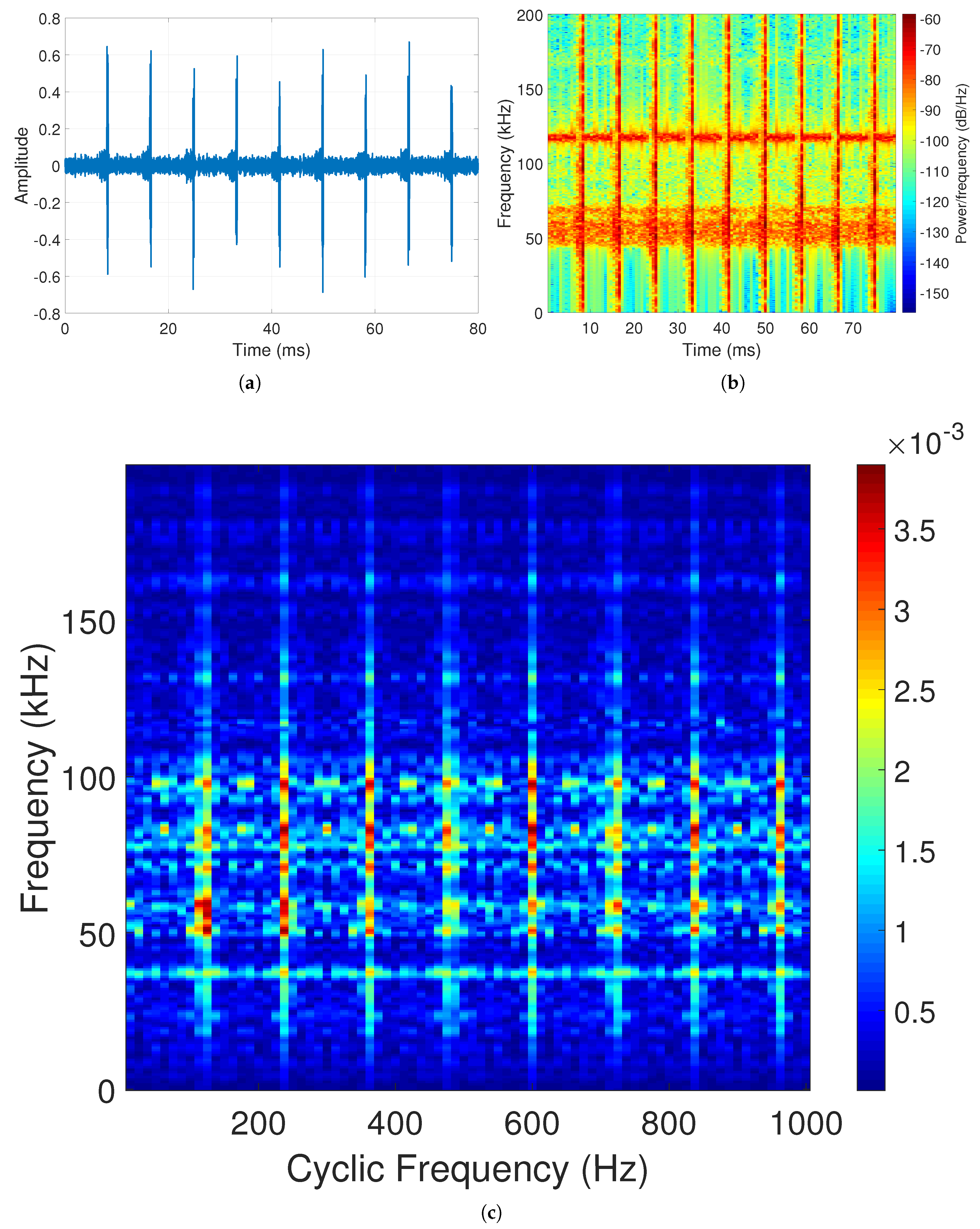
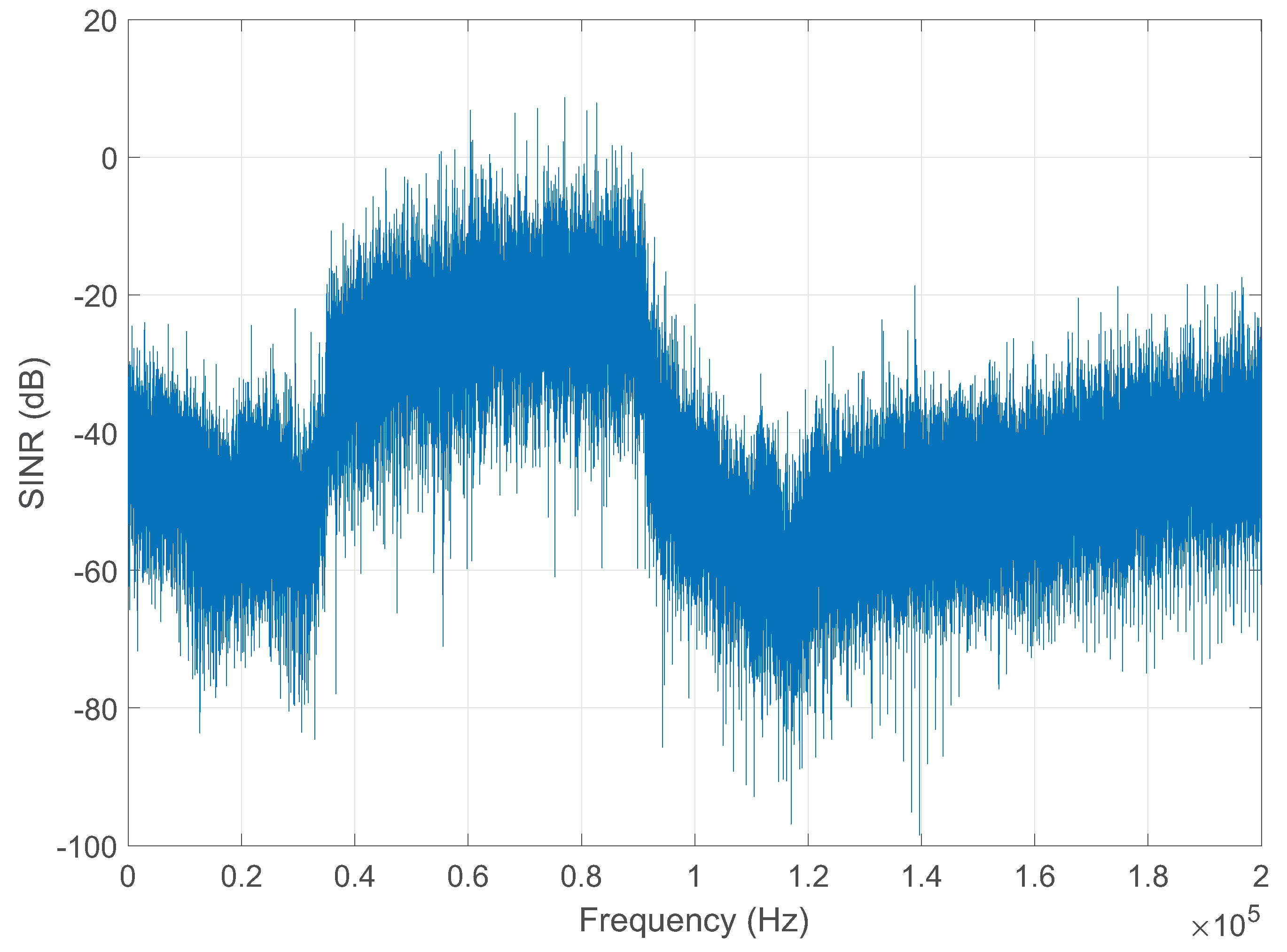
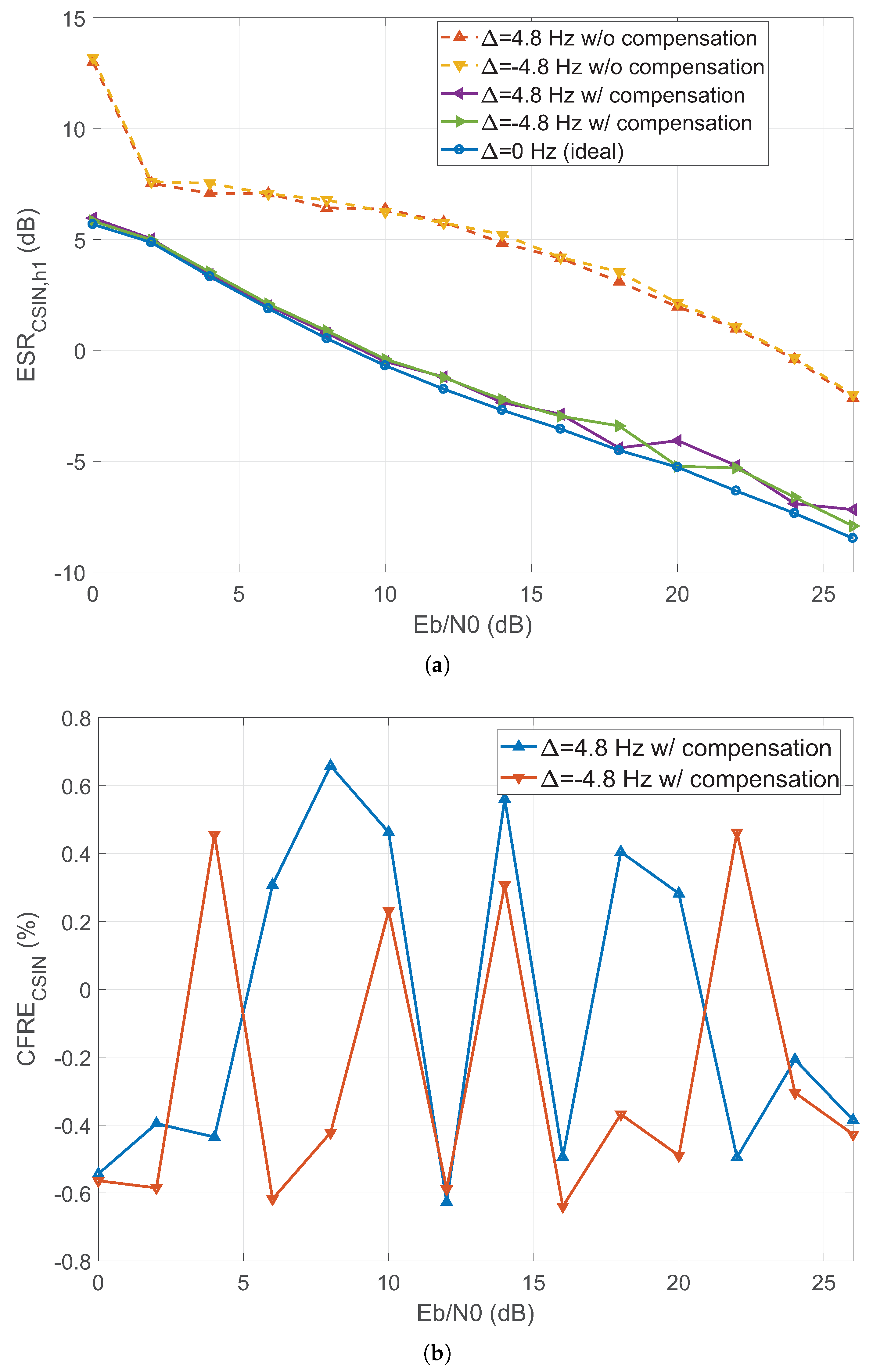
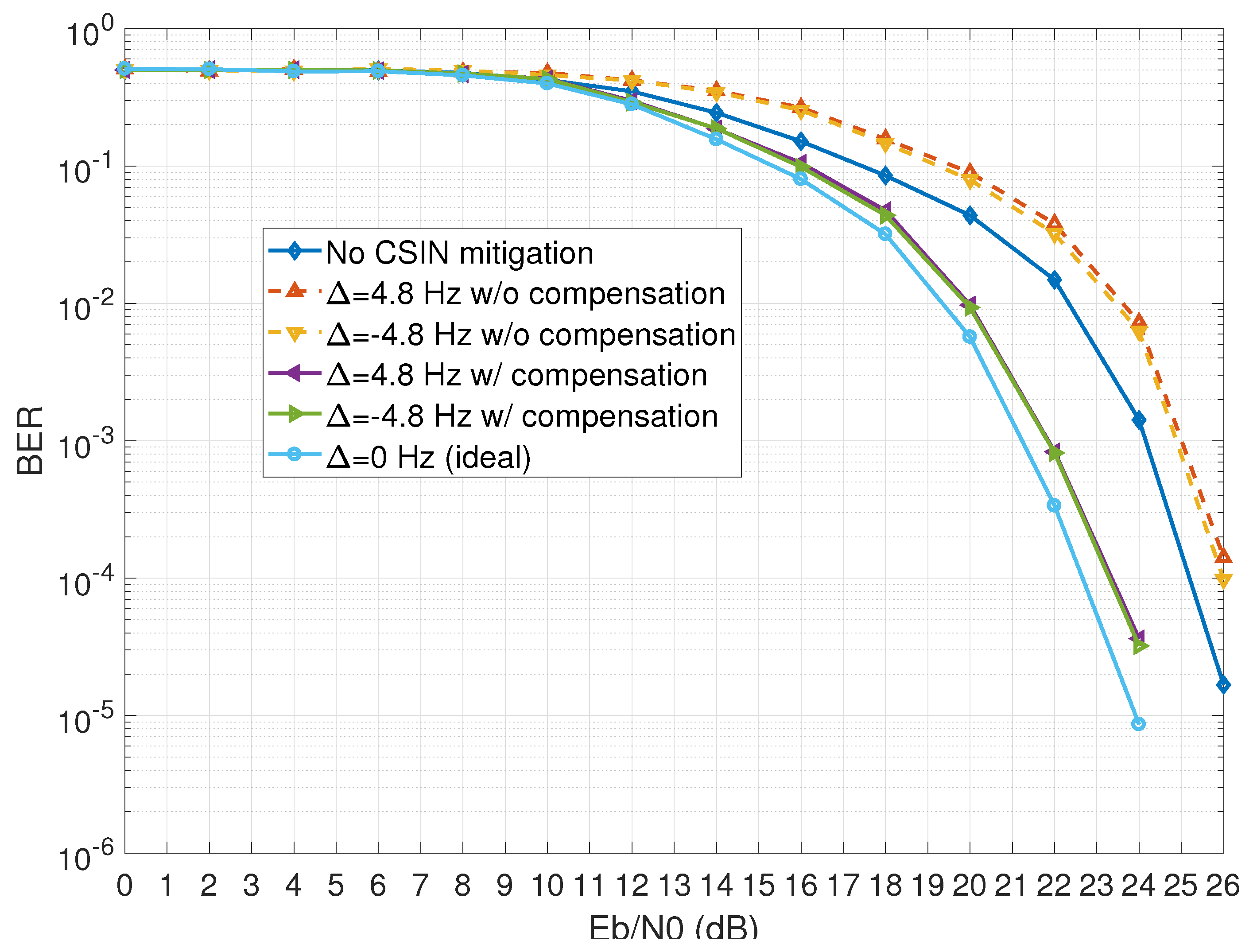
| Parameter | Value |
|---|---|
| Modulation | Differential binary phase shift keying (DBPSK) |
| Forward error correction (FEC) outer encoder | Reed-Solomon coding (RS(255,239)) |
| FEC inner encoder | Convolutional coding (r = 1/2, K = 7, ) |
| Frequency range | 35.9–90.6 kHz (CENELEC A) |
| Sampling rate () | 400 kHz |
| Fast Fourier transform (FFT) length () | 256 |
| Data subcarriers | 36 |
| Null subcarriers | 184 |
| Cyclic prefix (CP) length | 30 |
© 2020 by the authors. Licensee MDPI, Basel, Switzerland. This article is an open access article distributed under the terms and conditions of the Creative Commons Attribution (CC BY) license (http://creativecommons.org/licenses/by/4.0/).
Share and Cite
Chien, Y.-R.; Lin, J.-L.; Tsao, H.-W. Cyclostationary Impulsive Noise Mitigation in the Presence of Cyclic Frequency Offset for Narrowband Powerline Communication Systems. Electronics 2020, 9, 988. https://doi.org/10.3390/electronics9060988
Chien Y-R, Lin J-L, Tsao H-W. Cyclostationary Impulsive Noise Mitigation in the Presence of Cyclic Frequency Offset for Narrowband Powerline Communication Systems. Electronics. 2020; 9(6):988. https://doi.org/10.3390/electronics9060988
Chicago/Turabian StyleChien, Ying-Ren, Jian-Liang Lin, and Hen-Wai Tsao. 2020. "Cyclostationary Impulsive Noise Mitigation in the Presence of Cyclic Frequency Offset for Narrowband Powerline Communication Systems" Electronics 9, no. 6: 988. https://doi.org/10.3390/electronics9060988
APA StyleChien, Y.-R., Lin, J.-L., & Tsao, H.-W. (2020). Cyclostationary Impulsive Noise Mitigation in the Presence of Cyclic Frequency Offset for Narrowband Powerline Communication Systems. Electronics, 9(6), 988. https://doi.org/10.3390/electronics9060988






